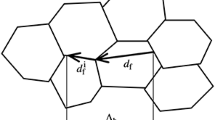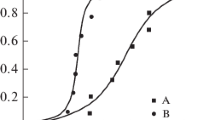Conclusions
-
1.
The brittle fracture mechanism was considered taking into consideration the results of earlier conducted works [29, 35, 46].
-
2.
To determine the brittle strength of iron alloys the equation
$$\sigma _{br} \cong 20 000\sqrt {\frac{r}{l},} $$where r is the radius at the crack tip (most probable 0.01 μm<r,0.1 μm) and ℓ is the crack length, which equal to the grain diameter (10–100 μm), is proposed.
-
3.
The values of brittle strength calculated using the porposed equation are a minimum since it does not take into consideration the energy consumed in overcoming obstacles to the growing crack in microplastic deformation. Grain boundaries are such obstacles. In brittle fracture the boundaries are more plastic than the volume of the grain and in ductile fracture the opposite.
Similar content being viewed by others
Articles published in Metallovedenie i Termicheskaya Obrabotka Metallov (metal science and heat treatment) on problems of brittle fracture
G. I. Pogodin-Alekseev, "The tendency of metals toward cold brittleness in static tension," Metallovedenie i Termicheskaya Obrabotka Metallov No. 2, 8–14 (1955).
V. I. Prosvirin and E. I. Kvashnina, "The position of the ductile-to-brittle transition temperature in temper brittleness," Metallovedenie i Termicheskaya Obrabotke Metallov No. 3, 17–20 (1955).
A. P. Gulyaev and I. I. Slavina, "The influence of residual austenite produced in hardening on the impact strength and form of fracture in high-temperature tempered chromenickel-molybdenum steel," Metallovedenie i Termicheskaya Obrabotka Metallov No. 3,15–17 (1956).
A. P. Gulyaev and N. P. Neverova-Skobeleva, "The influence of carbon on the position of the ductile-to-brittle transition range," Metallovedenie i Termicheskaya Obrabotka Metallov No. 4, 17–20 (1957).
L. A. Gaivoronskii, "An investigation of the cold brittleness of SKhL-4 steel after different heat treatments," Metallovedenie i Termicheskaya Obrabotka Metallov No. 9, 54–55 (1958).
A. P. Sanina and M. M. Timofeev, "An investigation of the cold brittleness of certain compositions of steel," Metallovedenie i Termicheskaya Obrabotka Metallov No. 8, 57–58 (1958).
B. G. Savitskii, K. V. Popov, V. F. Zakharov, and G. M. Grigor'eva, "The influence of alloying of low-carbon steel with chromium and manganese on its tendency toward brittle fracture," Metallovedenie i Termicheskaya Obrabotka Metallov No. 9, 49–51 (1959).
E. I. Uryupina, "Brittle fractures of austenitic steel parts," Metallovedenie i Termicheskaya Obrabotka Metallov No. 6, 43–45 (1960).
T. A. Vladimirskii, "The influence of various factors on the sensitivity of steel toward brittleness," Metallovedenie i Termicheskaya Obrabotka Metallov No. 5, 25–26 (1962).
A. P. Okenko and V. K. Shashkova, "The brittleness of Kh25T steel," Metallovedenie i Termicheskaya Obrabotka Metallov No. 10, 58–60 (1964).
A. V. Stanyukovich, "The rules of appearance of the tendency of steel toward brittle fracture at high and low temperatures," Metallovedenie i Termicheskaya Obrabotka Metallov No. 7, 2–7 (1964).
R. G. Arone, P. I. Sokolovskii, and S. V. Bernshtein, "An electron-fractographic investigation of fracture of low-alloy steel," Metallovedenie i Termicheskaya Obrabotka Metallov No. 6, 48–49 (1965).
G. I. Pododin-Alekseev, "The brittle and ductile conditions of metals," Metallovedenie i Termicheskaya Obrabotka Metallov No. 8, 12–16 (1965).
V. V. Lunev and Yu. A. Shul'te, "The influence of composition on the cold brittleness of cast medium-carbon steel," Metallovedenie i Termicheskaya Obrabotka Metallov No. 3, 55–57 (1966).
Yu. I. Matrosov and V. N. Zikeev, "The influence of impurities and alloy elements on the tendency of high-purity iron toward brittle fracture," Metallovedenie i Termicheskaya Obrabotka Metallov No. 11, 25–29 (1966).
I. E. Startseva, V. G. Moroz, and E. A. Subareva, "The influence of modifying additions on the cold brittleness of carbon and low-alloy steels," Metallovedenie i Termicheskaya Obrabotka Metallov No. 11, 22–24 (1966).
D. V. Lebedev and B. M. Ovsyannikov, "The design reliability of steels and alloys at low temperatures," Metallovedenie i Termicheskaya Obrabotka Metallov No. 7, 74–79 (1968).
A. P. Gulyaev and A. M. Kim-Khenkina, "The influence of carbon content, melting methods, and thermomechanical working on the brittle strength of steel," Metallovedenie i Termicheskaya Obrabotka Metallov No. 12, 28–33 (1969).
I. V. Shermazan, V. D. Zelenova, and A. P. Gulyaev "The influence of austenitic grain size and tempering temperature on the cold brittleness of steel," Metallovedenie i Termicheskaya Obrabotka Metallov No. 3, 23–27 (1970).
V. F. Gaiduchenya, D. V. Lebedev, and B. V. Molotilov, "The brittle fracture of coarsegrained silicon iron," Metallovedenie i Termicheskaya Obrabotka Metallov No. 9, 38–44 (1969).
V. D. Zelenova, "The brittle fracture resistance of steel with a surface-hardened case," Metallovedenie i Termicheskaya Obrabotka Metallov No. 6, 49–51 (1970).
V. N. Zikeev, B. M. Ovsyannikov, and G. V. Laz'ko, "Determination of the work for crack development of hardened and tempered constructional steels," Metallovedenie i Termicheskaya Obrabotka Metallov No. 6, 44–46 (1970).
L. N. Kosarev, "The resistance of the work of crack development according to the method of Gulyaev and Drozdovskii," Metallovedenie i Termicheskaya Obrabotka Metallov No. 6, 46–49 (1970).
Ya. R. Rauzin and A. V. Velikanov, "Modern methods of evaluation of fracture toughness," Metallovedenie i Termicheskaya Obrabotka Metallov No. 6, 28–36 (1970).
A. V. Taran, "Fracture toughness, the form of fracture, and test temperature of constructional steels," Metallovedenie i Termicheskaya Obrabotka Metallov No. 6, 37–43 (1970).
I. N. Bogachev, V. F. Egolaev, G. E. Zvigintseva, and T. L. Frolova, Metallovedenie i Termicheskaya Obrabotka Metallov No. 8, 51–53 (1972).
Yu. V. Shakhnazarov, E. D. Orlov, N. I. Vorob'eva, and A. P. Vasil'ev, "The fracture resistance of die steels," Metallovedenie i Termicheskaya Obrabotka Metallov No. 8, 48–50 (1972).
N. N. Morgunova, "The brittle fracture of metals," Metallovedenie i Termicheskaya Obrabotka Metallov No. 1, 9–11 (1972).
A. P. Gulyaev, "The strength and toughness of metallic materials," Metallovedenie i Termicheskaya Obrabotka Metallov No. 10, 72–75 (1973).
N. A. Kostenko, F. A. Bekerman, and I. S. Petrunina, "A statistical method of evaluation of the ductile-to-brittle transition temperature," Metallovedenie i Termicheskaya Obrabotka Metallov No. 5, 49–52 (1973).
A. I. Mezentsev and A. F. Mikhailov, "The question of the cold brittleness of metals," Metallovedenie i Termicheskaya Obrabotka Metallov No. 5, 46–49 (1973).
A. P. Gulyaev and V. M. Chulkova, "The character of fracture of high-manganese austenitic steel," Metallovedenie i Termicheskaya Obrabotka Metallov No. 4, 49–54 (1974).
K. Mazanets, V. Karel, P. Paguta, and L. Gispetska, "The influence of the original austenitic structure on the fracture mechanism of nickel steel martensite,", Metallovedenie i Termicheskaya Obrabotka Metallov No. 12, 8–12 (1974).
M. A. Kramarov, G. G. Kolchin, V. N. Lebedev, and Yu. P. Solntsev, "Determination of the fracture resistance of 35KhN3MFA steel for large billets," Metallovedenie i Termicheskaya Obrabotka Metallov No. 1, 14–16 (1976).
A. P. Gulyaev, "Ductile and brittle fracture of steel," Metallovedenie i Termicheskaya Obrabotka Metallov No. 7, 63–64 (1977).
A. P. Golyaev, Yu. S. Golovanenko, and V. N. Zikeev, "The influence of the quantity of nonmartensitic transformation products on the fracture resistance of hardened and tempered constructional steel," Metallovedenie i Termicheskaya Obrabotka Metallov No. 7, 60–67 (1978).
A. P. Gulyaev and A. N. Levanova "The brittleness of high-chromium ferritic stainless steels," Metallovedenie i Termicheskaya Obrabotka Metallov No. 11, 2–7 (1978).
V. M. Goritskii and L. I. Gladshtein, "Two forms of brittle fracture of hardened and tempered low-alloy steel," Metallovedenie i Termicheskaya Obrabotka Metallov No. 12, 33–35 (1978).
M. A. Krishtal and L. E. Epshtein, "Mechanical and physical features of fracture of metals," Metallovedenie i Termicheskaya Obrabotka Metallov No. 4, 2–13 (1978).
V. I. Sarrak and G. A. Fillipov, "The brittleness of martensite," Metallovedenie i Termicheskaya Obrabotka Metallov No. 4, 21–26 (1978).
N. S. Kogut, "The fracture resistance of certain constructional materials at low temperatures," Metallovedenie i Termicheskaya Obrabotka Metallov No. 7, 49–51 (1979).
S. N. Polyakov, V. M. Kondratenko, and N. I. Padun, "Evaluation of the brittle fracture tendency of carbon steels," Metallovedenie i Termicheskaya Obrabotka Metallov No. 12, 43–44 (1979).
A. P. Gulyaev and T. F. Volynova, "The cold brittleness of α-, ε-, and γ-solid solutions of Fe−Mn system alloys," Metallovedenie i Termicheskaya Obrabotka Metallov No. 2, 17–23 (1979).
L. R. Botvina and G. V. Klevtsov, "Macro- and microfractographic features of the dispersed fracture toughness of 45 steel in the ductile-to-brittle transition range," Metallovedenie i Termicheskaya Obrabotka Metallov No. 2, 27–29 (1985).
G. M. Sorokin, S. N. Bobrov, and N. I. Shumovskii, "The fracture toughness of high-strength alloy steels in impact loading," Metallovedenie i Termicheskaya Obrabotka Metallov No. 8, 28–31 (1987).
A. P. Gulyaev, "Brittle and ductile fracture," Metallovedenie i Termicheskaya Obrabotka Metallov No. 10, 7–8 (1987).
A. V. Vikulin and Yu. P. Solntsev, "A method of constructional steels for operation at low temperature," Metallovedenie i Termicheskaya Obrabotka Metallov No. 11, 38–41 (1990).
Additional information
Translated from Metallovedenie i Termicheskaya Obrabotka Metallov, No. 2, pp. 21–26, February, 1992.
Rights and permissions
About this article
Cite this article
Gulyaev, A.P. Brittle fracture resistance. Met Sci Heat Treat 34, 110–119 (1992). https://doi.org/10.1007/BF00769877
Issue Date:
DOI: https://doi.org/10.1007/BF00769877




